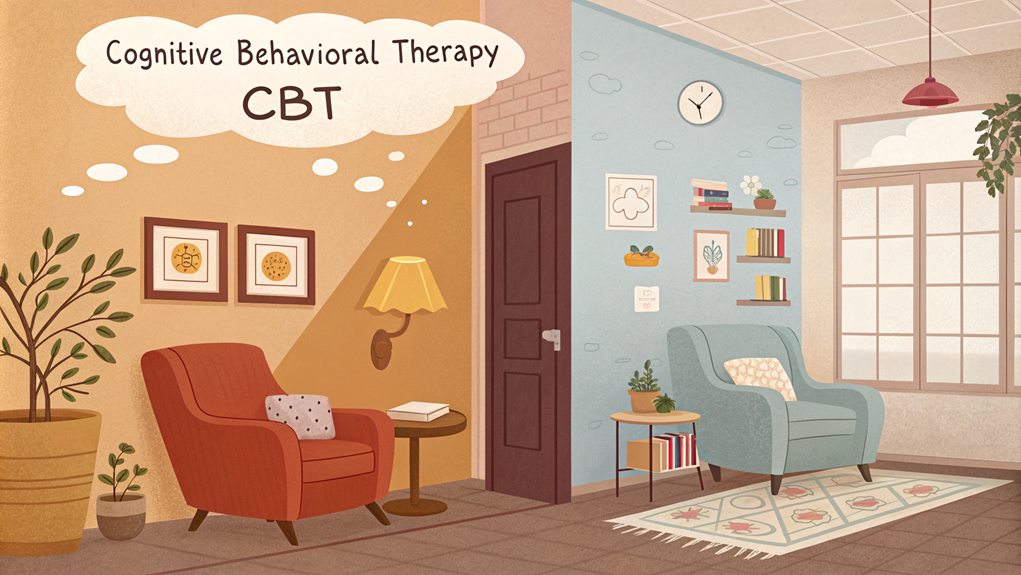
You might find it intriguing how Cognitive Behavioral Therapy (CBT) emerged as a response to the limitations of traditional psychoanalysis, where dreams and deep-seated fears often took center stage. In the mid-20th century, pioneers like Aaron Beck sought to illuminate the cognitive distortions that shape our present reality, shifting focus from the unconscious to the conscious thought patterns that influence our emotional states. This evolution raises questions about the balance between understanding our past and addressing our current perceptions—what happens when we confront those thoughts head-on?
Historical Background of CBT

Emerging from the interplay of psychoanalysis and behaviorism, Cognitive Behavioral Therapy (CBT) has roots that trace back to the mid-20th century. You might find it fascinating that this therapeutic approach arose during a time when psychology was grappling with the complexities of human thought and behavior. Pioneers like Aaron Beck began to challenge the traditional psychoanalytic view, focusing more on the present and how thoughts influence feelings and actions. Research into therapeutic interventions for cognitive disorders also began to inform the development of CBT, emphasizing the importance of addressing cognitive distortions in various mental health issues.
As you explore the historical context, consider how this shift mirrored the evolving understanding of the mind. Beck's work on cognitive distortions laid the groundwork for recognizing that your perceptions can shape your reality. This was a significant departure from Freud's emphasis on unconscious processes and dream analysis, which sought to uncover hidden motivations.
During this era, the integration of behavioral techniques also gained traction, highlighting the importance of observable actions. By blending these two schools of thought, CBT emerged as a practical approach, rooted in the belief that changing your thoughts can lead to meaningful changes in behavior and emotional well-being. This historical evolution reflects a broader quest for understanding the mind's complexities, offering you valuable insights into your own mental health journey.
Key Principles of CBT
As you explore the key principles of Cognitive Behavioral Therapy, consider how your thoughts shape your emotional landscape. Understanding the role of cognitive rehabilitation can enhance your journey towards emotional well-being, as it focuses on improving cognitive functions post-injury or illness, which can also influence your mental health cognitive rehabilitation techniques. By identifying cognitive distortions and understanding the thought-emotion connection, you can begin to unravel the complexities of your internal dialogue. Behavioral activation techniques will further guide you in transforming these insights into meaningful change, echoing historical influences that have shaped therapeutic practices.
Cognitive Distortions Identification
Cognitive distortions, lurking beneath the surface of our thoughts, can greatly skew our perception of reality. These mental missteps often originate from deep-seated beliefs and past experiences, much like the hidden meanings in dreams that Freud emphasized. Recognizing these distortions is essential, especially considering how severe brain injuries can lead to cognitive impairments and impact one's mental processes, as seen in the case of brain injury therapy advancements. By recognizing these distortions, you can begin to unravel the layers of your psyche, revealing how your perceptions may be influenced by historical context and personal narratives.
Consider these common cognitive distortions:
- All-or-Nothing Thinking: Viewing situations in black and white, without recognizing the gray areas.
- Catastrophizing: Expecting the worst possible outcome, leading to increased anxiety and distress.
- Overgeneralization: Drawing broad conclusions based on a single event, which can distort your overall self-image.
Behavioral Activation Techniques
Recognizing cognitive distortions sets the stage for implementing behavioral activation techniques, which serve to counteract the negative thought patterns that often accompany them. These techniques encourage you to engage in activities that align with your values and interests, effectively reviving your sense of purpose. Historically rooted in psychoanalytic principles, behavioral activation draws on the idea that actions influence emotions, much like the symbolic meanings found in dreams. This approach can also be seen as a way to address cognitive dissonance, where conflicting thoughts may hinder emotional well-being.
Consider your past experiences; you might recall moments when engaging in a fulfilling activity shifted your mood, much like the resolution of a dream's tension. By scheduling pleasurable or meaningful tasks, you disrupt the cycle of avoidance that arises from those distorted thoughts.
You're encouraged to explore new activities or revisit old hobbies, allowing your unconscious to guide you in rediscovering joy. This process mirrors dream analysis, where the exploration of suppressed desires leads to insight and healing. As you implement these techniques, you'll start to notice a gradual shift in your emotional landscape, providing you with a clearer path to understanding the interplay between your thoughts and actions, thereby laying the groundwork for deeper therapeutic work.
Thought-Emotion Connection
Throughout history, the intricate dance between thoughts and emotions has captivated thinkers and therapists alike. You've likely experienced how your thoughts can shape your feelings, creating a feedback loop that influences your daily life. This relationship is foundational in Cognitive Behavioral Therapy (CBT), where understanding this connection can lead to transformative insights.
In CBT, you'll explore how your cognitive patterns can create emotional responses. By examining these thoughts, you can identify distortions and challenge negative beliefs.
Consider these key points:
- Cognitive Distortions: Recognize how irrational thoughts can trigger emotional distress.
- Emotional Awareness: Understand your feelings as valuable signals that reflect underlying thoughts.
- Cognitive Restructuring: Modify maladaptive thoughts to foster healthier emotional responses.
This process echoes the historical context of psychoanalysis, where dream analysis often revealed hidden conflicts between thoughts and emotions. Through CBT, you engage actively with your cognitive processes, much like a dreamer interpreting their subconscious. By addressing the thought-emotion connection, you empower yourself to break free from cycles of negativity, ultimately leading to a more balanced emotional life.
Development of CBT Techniques

As you explore the development of CBT techniques, consider how historical influences shaped its evolution from psychoanalytic roots. You'll find that key therapeutic techniques emerged as a response to the limitations of earlier approaches, integrating insights from dream analysis and behaviorism. By understanding these evolving treatment approaches, you can appreciate how CBT became an essential tool in modern psychotherapy.
Historical Background of CBT
Cognitive Behavioral Therapy (CBT) has a rich historical background that intertwines various psychological theories and practices. You'll find its roots stretching back to the early 20th century, where psychoanalysis and behaviorism laid the groundwork for its development. Early pioneers like Sigmund Freud emphasized the importance of unconscious processes, while B.F. Skinner's work on behaviorism introduced the concept of conditioning. These influences shaped the understanding of how thoughts, emotions, and behaviors interact.
Key milestones in CBT's evolution include:
- Albert Ellis's Rational Emotive Behavior Therapy (REBT): Pioneering the idea that irrational beliefs lead to emotional distress.
- Aaron Beck's Cognitive Therapy: Focused on identifying and altering negative thought patterns.
- Integration of Behavioral Techniques: Drawing on exposure therapy and reinforcement strategies to modify behaviors.
As you explore CBT, recognize how these historical contexts and theoretical underpinnings create a framework for understanding human behavior. By examining dreams and unconscious motivations, CBT not only addresses immediate concerns but also integrates a deeper understanding of the self, leading to profound therapeutic breakthroughs.
Key Therapeutic Techniques
The evolution of Cognitive Behavioral Therapy (CBT) is marked by a variety of therapeutic techniques that have emerged from its foundational theories. You'll find that one of the core techniques is cognitive restructuring, where you identify and challenge distorted thoughts, much like peeling back layers of a dream to uncover hidden meanings. This approach draws on the psychoanalytic tradition, emphasizing the relationship between your thoughts and emotions, allowing for deeper self-exploration.
Another key technique is exposure therapy, where you gradually confront fears in a controlled environment. This mirrors the process of dream analysis, where confronting repressed emotions can lead to significant insights. Historically, these techniques have evolved, blending principles from both behaviorism and psychoanalysis, showcasing an integration of past and present.
Behavioral activation is also essential, encouraging you to engage in fulfilling activities that counteract depressive symptoms. This method parallels the release of repressed desires in dreams, fostering a more vibrant emotional life. By employing these techniques, you tap into a rich tapestry of psychological understanding, paving the way for transformative change in your life. Each method reflects a journey through the subconscious, revealing underlying patterns that shape your mental landscape.
Evolving Treatment Approaches
Over time, treatment approaches in Cognitive Behavioral Therapy (CBT) have evolved, reflecting a deeper understanding of the mind's complexities. You may find it intriguing to note how these shifts have been influenced by both historical context and psychoanalytic principles. Initially, CBT focused primarily on the connection between thoughts, feelings, and behaviors. However, as practitioners recognized the importance of unconscious processes, techniques began to incorporate elements of dream analysis and emotional exploration.
Consider these evolving techniques:
- Mindfulness integration: This approach encourages awareness of present thoughts and feelings, helping you to observe rather than react.
- Schema-focused therapy: Here, you explore underlying beliefs formed in childhood, revealing how they shape your current behavior.
- Emotionally focused therapy: This method emphasizes processing and validating emotions, allowing you to understand their role in your mental health.
Effectiveness of CBT
While many therapeutic approaches have emerged over the years, few have demonstrated the same level of empirical support as CBT. This method's effectiveness lies in its structured exploration of thoughts and behaviors, akin to analyzing dreams to uncover underlying conflicts. As you engage with CBT, you're not merely addressing symptoms; you're probing into the historical context of your thoughts and feelings, much like a psychoanalyst investigates the personal history behind your dreams.
CBT empowers you to identify cognitive distortions, which often act as the barriers to your emotional well-being. By confronting these distortions, you begin to reshape your reality. The historical evolution of CBT reflects a shift from purely introspective analysis to an active, problem-solving approach, making it particularly effective for conditions like depression and anxiety.
This therapy's success is bolstered by a wealth of research showing significant, lasting improvements in mental health. As you apply CBT techniques, you're participating in a legacy that bridges the gap between the depths of psychoanalysis and the practicalities of modern therapy, ultimately guiding you toward greater self-awareness and emotional resilience.
CBT vs. Other Therapies

When comparing CBT with other therapeutic approaches, you'll find it offers a unique lens through which to investigate your psyche. Unlike psychoanalysis, which probes deeply into your unconscious and dreams, CBT focuses on the here and now, emphasizing your thoughts and behaviors. This pragmatic approach can feel more accessible, especially when you're seeking immediate relief from distress.
In historical context, while Freud's theories shaped early therapy, CBT emerged as a response to the need for structured, goal-oriented methods. You might appreciate how CBT contrasts with other therapies:
- Psychoanalysis: Focuses on exploring unconscious motives and childhood experiences.
- Humanistic Therapy: Centers on self-actualization and personal growth, often through unconditional positive regard.
- Acceptance and Commitment Therapy (ACT): Emphasizes acceptance and mindfulness, often diverging from the cognitive restructuring seen in CBT.
Each approach has its merits, but CBT's emphasis on actionable strategies can resonate with those looking for a straightforward path to change. By understanding these differences, you can make informed decisions about which therapy aligns best with your needs and goals.
Applications of CBT
As you explore the applications of Cognitive Behavioral Therapy (CBT), you'll find it serves a broad spectrum of mental health issues, promoting tangible change in your daily life. Historically rooted in psychoanalysis, CBT diverges by focusing on the here-and-now, emphasizing the connections between your thoughts, feelings, and behaviors. This approach allows you to dissect your cognitive patterns and uncover the unconscious motives behind your actions, much like dream analysis reveals hidden truths in your subconscious.
In practice, you might use CBT to tackle anxiety, depression, or even phobias. By identifying distorted thinking, you challenge these perceptions, reshaping your reality. For instance, when grappling with anxiety, you might learn to recognize catastrophic thoughts and replace them with more balanced alternatives. The technique empowers you to confront fears gradually, fostering resilience and self-awareness.
Additionally, CBT's applications extend to chronic pain, insomnia, and even stress management. By integrating historical perspectives on behavior and thought processes, you can better understand your emotional landscape. Ultimately, CBT equips you with practical tools to navigate life, enabling you to transform your internal narratives and enhance your well-being.
Training and Certification in CBT

Understanding the applications of Cognitive Behavioral Therapy (CBT) lays a foundation for recognizing the importance of proper training and certification for practitioners. Just as dreams reveal the unconscious mind, the training process discloses the intricacies of human thought patterns and behaviors. You need a robust understanding of CBT's principles to guide clients through their cognitive distortions effectively.
When seeking training in CBT, consider these essential aspects:
- Accredited Programs: Confirm the program is recognized by professional organizations, reflecting a standard of excellence.
- Supervised Practice: Engage in supervised clinical experiences to apply theoretical knowledge in real-world settings.
- Continuing Education: Stay updated with ongoing workshops and courses, as the field of psychology evolves rapidly.
Future Trends in CBT
Emerging from the depths of psychological practice, the future of Cognitive Behavioral Therapy (CBT) is poised to intertwine with advancements in technology and neuroscience. As you explore this evolving landscape, consider how digital platforms and virtual reality could enhance traditional CBT methods. These innovations might allow you to engage in immersive experiences that facilitate exposure therapy, tapping into your subconscious fears and dreams.
Historically, Freud emphasized the significance of dreams in understanding the psyche. Future trends in CBT may revive this interest by integrating dream analysis with cognitive restructuring techniques. You might find that exploring the narratives within your dreams can offer profound insights into your thought patterns and emotional responses.
Moreover, as neuroscience continues to illuminate the brain's workings, you may witness a shift in how therapists approach CBT. Understanding neural pathways could refine strategies, allowing you to rewire maladaptive thoughts more effectively.
The future of CBT isn't just about treatment; it's about evolving your understanding of the self. By embracing these innovations, you can commence on a journey toward deeper self-awareness and emotional resilience, ultimately reshaping your mental landscape.
Personal Experiences With CBT

Cognitive Behavioral Therapy (CBT) often becomes a pivotal journey for individuals seeking to unravel the complexities of their mind. As you engage in this therapeutic process, you might encounter layers of thought patterns that reveal deeper emotional truths. Your experiences with CBT can serve as a mirror, reflecting not just your conscious thoughts but also tapping into unconscious fears and desires.
- You learn to identify cognitive distortions, illuminating how these thoughts shape your reality.
- By exploring the historical context of your beliefs, you can understand their origins in past experiences or dreams.
- Engaging in experiential exercises, you might find connections between your current struggles and unresolved emotions from earlier life stages.
Through this lens, CBT helps you navigate your psyche, transforming your understanding of self. You may begin to see that your thoughts aren't merely products of circumstance; they can be restructured, much like the narratives in your dreams. This process fosters a sense of empowerment, allowing you to reshape your internal dialogue and embrace a more balanced perspective on life. Ultimately, your personal journey with CBT can lead to profound insights and lasting change.
Read The Next Blog Post –
As you reflect on the evolution of Cognitive Behavioral Therapy, consider how it bridges the gap between analytical thought and the realities of daily life. Isn't it fascinating how understanding your thoughts can alter your emotional landscape? By embracing CBT's principles, you can unveil new pathways to healing, transforming your dreams of a fulfilling life into tangible reality. The history of CBT isn't just a story of therapy; it's a proof of the power of self-awareness and growth.














